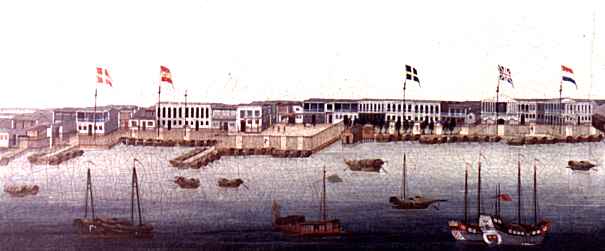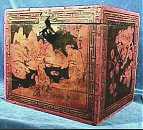


 Silks, spices, tea and porcelain. These and other exotic products of China had been eagerly sought by Europeans since Roman times. But the land route through the Euroasian deserts along the "Silk Route" allowed only a trickle of Oriental products to reach the Western World.
Silks, spices, tea and porcelain. These and other exotic products of China had been eagerly sought by Europeans since Roman times. But the land route through the Euroasian deserts along the "Silk Route" allowed only a trickle of Oriental products to reach the Western World.
 In the 16th century the sea route to the Orient was discovered. In the centuries that followed the seafaring nations of Europe vied for control of the China Trade. In the early 18th century, the collection of Oriental products became an obcession among the European aristocracy. Separate rooms and castles were built to display the collections of the most devoted such as Alexander the Strong of Saxony.
In 1731 a Swedish East India Company was founded inheriting most of its knowhow from the Austrian "Ostende" company.
In the 16th century the sea route to the Orient was discovered. In the centuries that followed the seafaring nations of Europe vied for control of the China Trade. In the early 18th century, the collection of Oriental products became an obcession among the European aristocracy. Separate rooms and castles were built to display the collections of the most devoted such as Alexander the Strong of Saxony.
In 1731 a Swedish East India Company was founded inheriting most of its knowhow from the Austrian "Ostende" company.
The Chinese regarded all foreigners with suspicion and contact with the "Foreign Devils" was severely restricted. Trading was allowed only in Canton and only under the supervision of Chinese "Hong" merchants. Foreign traders were not even permitted to live in Canton and could only visit their warehouses during the trading season.
 Once trading was finished, the cargo was loaded - porcelain in bundles, tubs and wooden boxes cushioned with rice paddy or marketable goods such as gallingall, pepper, rice, sago, or tea, at the bottom for ballast, followed by chests of tea and finally the precious silks and spices.
Once trading was finished, the cargo was loaded - porcelain in bundles, tubs and wooden boxes cushioned with rice paddy or marketable goods such as gallingall, pepper, rice, sago, or tea, at the bottom for ballast, followed by chests of tea and finally the precious silks and spices.
The China Trade was a risky venture. Taxes, tributes, bribes and deceptions were rife. Storms, pirates, disease and rival traders were constant threats during the two-year round trip voyage from Europe. Most went well but sometimes disaster struck - as with the Gotheborg. Despite the risks, traders made huge profits for their companies, themselves and their countries.